Steel bridges are widely used around the world in different structural forms with different span length, such as highway bridges, railway bridges, and footbridges. The main advantages of structural steel over other construction materials are its strength, ductility, easy fabrication, and rapid construction. It has a much higher strength in both tension and compression than concrete, and relatively good strength to cost ratio and stiffness to weight ratio. Steel is a versatile and effective material that provides efficient and sustainable solutions for bridge construction, particularly for long span bridges or bridges requiring enhanced seismic performance.
Amongst bridge materials steel has the highest and most favorable strength qualities, and it is therefore suitable for the most daring bridges with the longest spans. Normal building steel has compressive and tensile strengths of 370 N/sq mm, about ten times the compressive strength of a medium concrete and a hundred times its tensile strength. A special merit of steel is its ductility due to which it deforms considerably before it breaks, because it begins to yield above a certain stress level.
Advantages of Steel bridge structure
The multiple advantages of steel equate to a more cost-effective option than other building materials. Smaller crews working with smaller scale construction equipment can install and erect steel-based projects because of its light weight. This lighter weight also allows for faster installation, so projects are erected more quickly. This timeliness also affords key cost-savings advantages to construction companies. Some of its advantages are-
- Lower construction costs compared with other materials helps save money for municipal governments. Faster construction reduces traffic and business disruption.
- Steel bridges last longer than other types, which means they don’t have to be replaced as quickly. Steel components require less maintenance and don’t need to be replaced as often.
- Steel is highly adaptable to different climates and geographic conditions. The relative lightness of steel compared with other materials reduces energy use during delivery and construction.
- Steel components are less likely to be damaged during extreme events like hurricanes and earthquakes. Steel components are used to transmit critical utility services across bridges.
- Steel has a remarkably high strength-to-weight ratio. This minimizes the weight of bridge superstructures, which reduces the cost of building the substructures that support them.
- One of the biggest advantages of steel is weight savings, which means lower erection costs, since the bridge pieces can be handled with lighter equipment. In addition, for the same span and load, a steel girder requires less depth than a concrete girder, which can be helpful when constrained by vertical clearance requirements.
- Generally, it’s easier to make spans continuous for both live and dead loads and to develop composite action with steel designs rather than with concrete ones.
- It’s easier to inspect and determine the structural state of a steel bridge where all the components are visible. The long-term durability and cost effectiveness of steel bridges will be further enhanced by the use of high performance steels with weathering capabilities.
- Steel permits cost-effective longer spans for crossing streams, lakes, wetlands, and environmentally protected areas. The long spans may eliminate or at least minimize environmental impact.
Elements and components of steel bridge
The structural steel for steel bridges should be selected according to the required material properties or the stress state where used, environmental conditions at the construction site, corrosion protection method, construction method, etc. The physical properties of structural steel such as strength, ductility, toughness, weldability, weather resistance, chemical composition, shape, size, and surface characteristics are important factors for designing and construction of steel bridges. Discussed below are elements and components of steel bridge.
Foundation
It is basically the part which is below the ground level. It can be of various types depending on the design. For eg : Open foundation, Well foundations and Pile foundations. On the top of well foundations and pile foundations a cap is provided. The function of the cap is to transmit loads from the component above it to the foundation which then eventually transfers it on the strata.
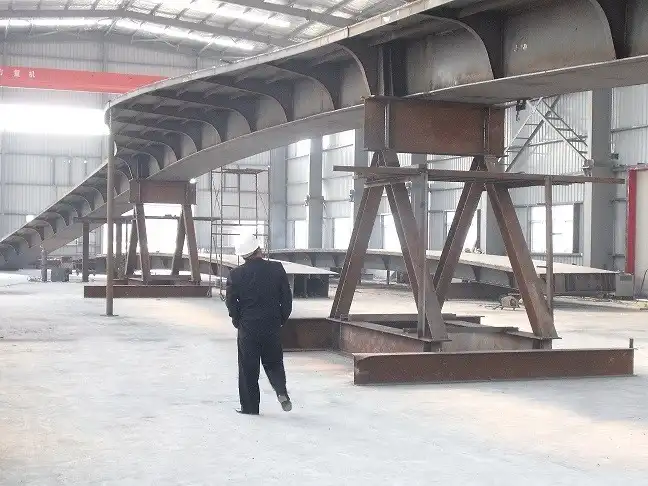
Planks
Planks are characterized by elongated, rectangular dimensions determined by the intended bridge use. Plank thickness is dependent upon the distance between the supporting points and the magnitude of the vehicle load. Common nominal or rough sawn dimensions for timber planks are 2 to 4 inches thick and 6 to 12 inches wide. Dressed lumber dimensions would be 1 ½ inches x 11 ¼ inches
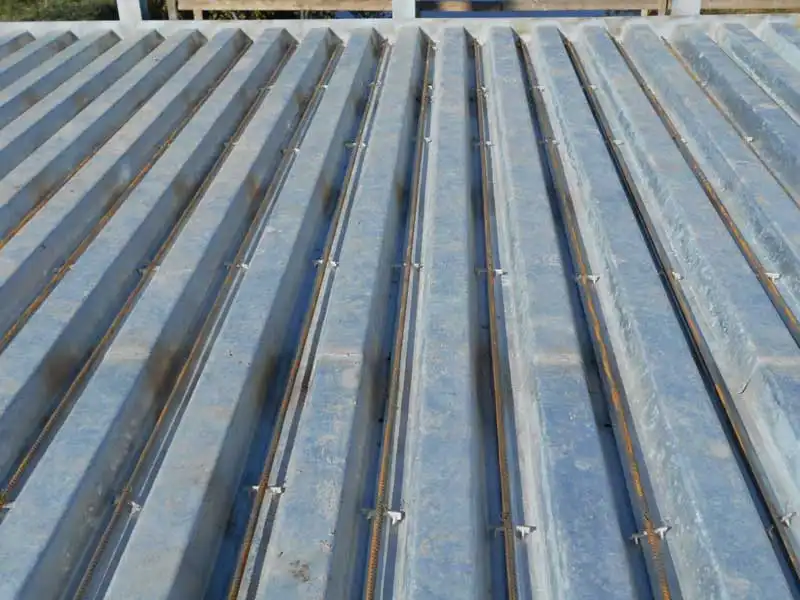
Deck
A deck is the surface of a bridge. A structural element of its superstructure, it may be constructed of concrete, steel, open grating, or wood. Sometimes the deck is covered with a railroad bed and track, asphalt concrete, or other form of pavement for ease of vehicle crossing. A concrete deck may be an integral part of the bridge structure (T-beam or double tee structure) or it may be supported with I-beams or steel girders. When a bridge deck is installed in a through truss, it is sometimes called a floor system. A suspended bridge deck will be suspended from the main structural elements on a suspension or arch bridge. On some bridges, such as a tied-arch or a cable-stayed, the deck is a primary structural element, carrying tension or compression to support the span.
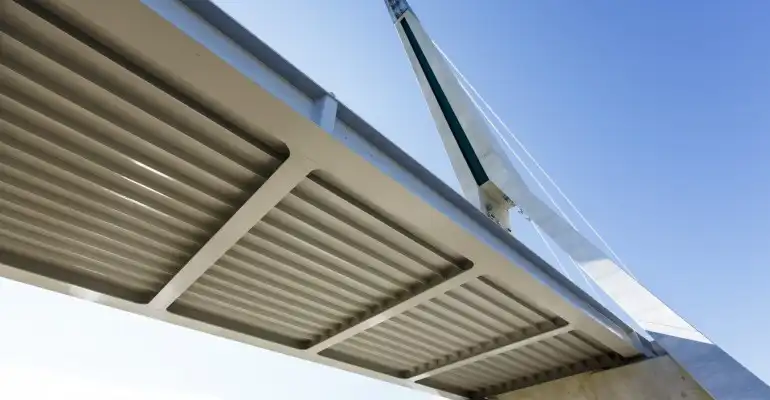
Superstructure
In a bridge, the portion of the structure that is the span and directly receives the live load is referred to as the superstructure. In contrast, the abutment, piers, and other support structures are called the substructure. It starts with girders or T-beams, deck slab which is also known as carriageway, railings, crash barriers, footpath, median. Hope that answers your question. Feel free to drop any messages for any other clarification. The superstructure of a bridge is the main structure supporting the span – into which all loads feed, and upon which all other structural members rest.
Substructure
It consists of piers and abutment shafts or walls, hammerhead, bedblock, pedestals and bearings and various other components. Sub-structure consists of piling works, footings, shafts, diaphragm walls, coping, all pertains to the foundation of structure.
Grider
A girder may be made of concrete or steel. Many shorter bridges, especially in rural areas where they may be exposed to water overtopping and corrosion, utilize concrete box girder. The term “girder” is typically used to refer to a steel beam. In a beam or girder bridge, the beams themselves are the primary support for the deck, and are responsible for transferring the load down to the foundation. Material type, shape, and weight all affect how much weight a beam can hold. Due to the properties of the second moment of area, the height of a girder is the most significant factor to affect its load capacity. Longer spans, more traffic, or wider spacing of the beams will all directly result in a deeper beam.
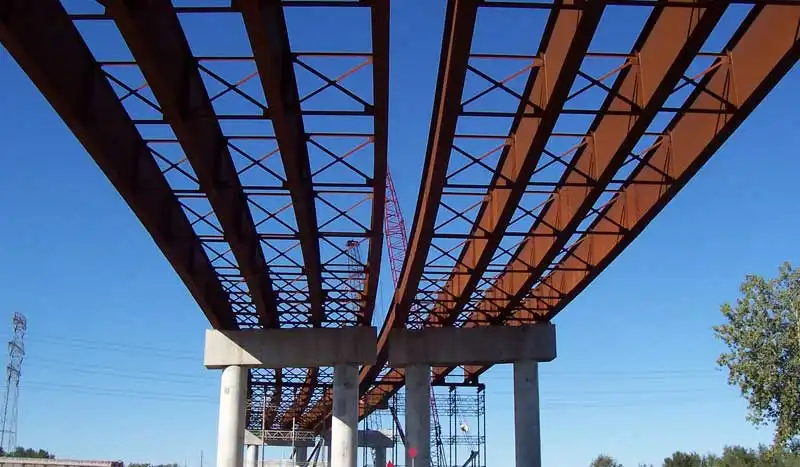
Beam
Beam are often only used for relatively short distances because, unlike truss bridges, they have no built in supports. The only supports are provided by piers. The farther apart its supports, the weaker a beam bridge gets. As a result, beam bridges rarely span more than 250 feet (80 m). This does not mean that beam bridges are not used to cross great distances; it only means that a series of beam bridges must be joined together, creating what is known as a continuous span.
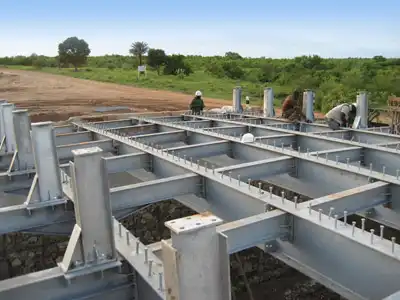
Pier
Piers are designed to resist vertical and horizontal loads from superstructures and to transfer them to the foundation. In addition to loads from superstructures, piers are designed to accommodate loads such as wind, water pressure, and vehicle collision. Piers are constructed with different shapes such as circular, rectangular, composite shapes. Piers can be classified into a multi-column pier, pile bent, pile encased pier, and hammerhead pier.
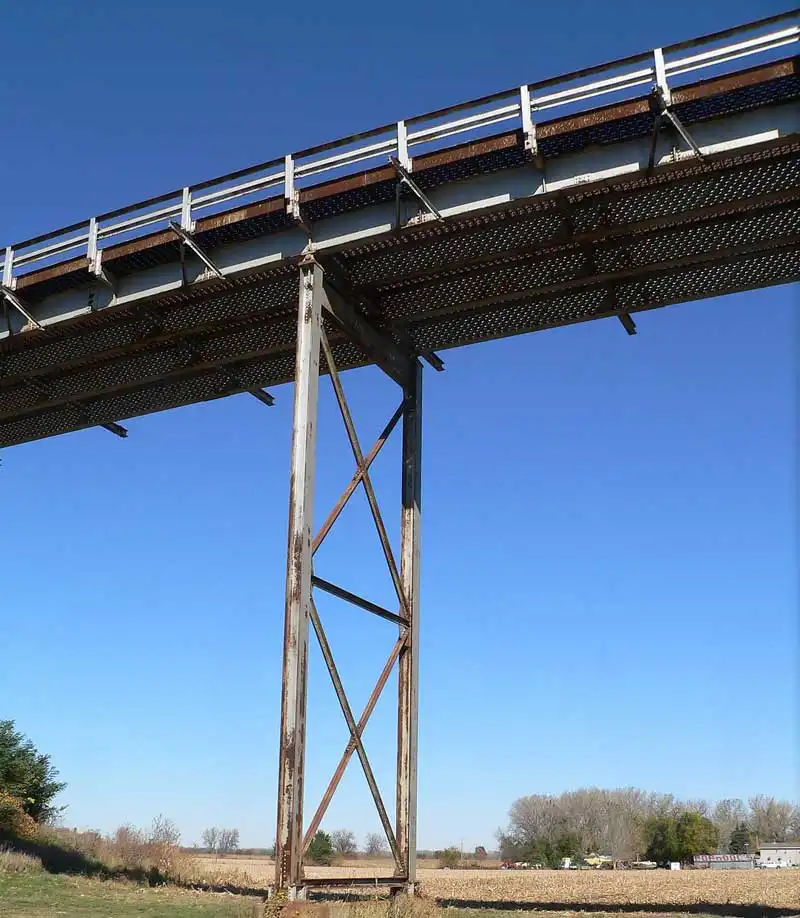
Bearing
bearing is a component of a bridge which typically provides a resting surface between bridge piers and the bridge deck. The purpose of a bearing is to allow controlled movement and thereby reduce the stresses involved. Possible causes of movement are thermal expansion and contraction, creep, shrinkage, or fatigue due to the properties of the material used for the bearing. External sources of movement include the settlement of the ground below, thermal expansion, and seismic activity.There are several different types of bridge bearings which are used depending on a number of different factors including the bridge span, loading conditions, and performance specifications. The oldest form of bridge bearing is simply two plates resting on top of each other. A common form of modern bridge bearing is the elastomeric bridge bearing. Another type of bridge bearing is the mechanical bridge bearing. There are several types of mechanical bridge bearing, such as the pinned bearing, which in turn includes specific types such as the rocker bearing, and the roller bearing. Another type of mechanical bearing is the fixed bearing, which allows rotation, but not other forms of movement.
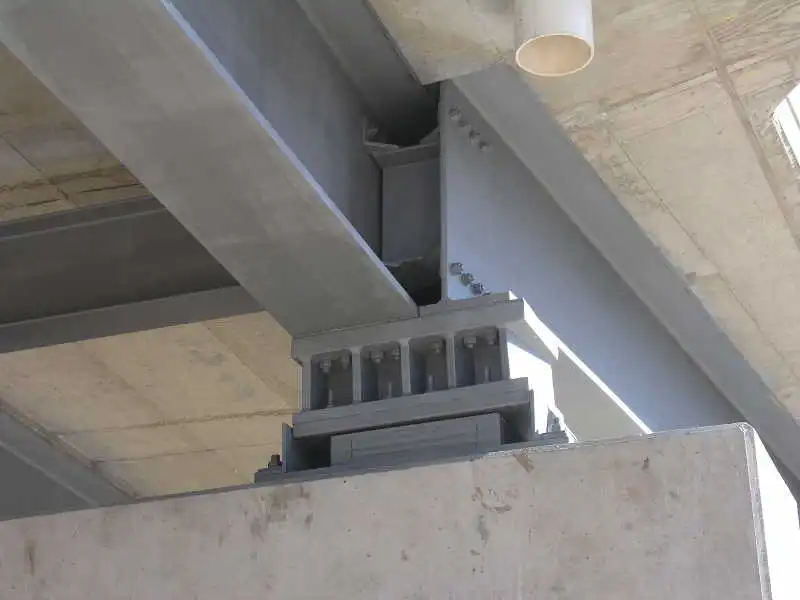
Pile Caps
A pile cap is a concrete slab 2m thick, up to 12m x 12m wide, that rests on groups of between 8 and 16 piles (depending on the size required) The pile cap provides a strong stable foundation for the pier, and up to 205m3 of concrete can be used in a single pile cap.
Anchor’
Anchor is an apparatus which holds a floating object to the bottom or any device for holding an object to the ground or to other fixed objects. In a bridge consisting of a series of cantilevers, the span that separates two cantilever arms of other spans is termed an anchor span.

Suspension cable
The suspension cables must be anchored at each end of the bridge since any load applied to the bridge is transformed into a tension in these main cables. The main cables continue beyond the pillars to deck-level supports, and further continue to connections with anchors in the ground. The roadway is supported by vertical suspender cables or rods, called hangers. In some circumstances, the towers may sit on a bluff or canyon edge where the road may proceed directly to the main span, otherwise the bridge will usually have two smaller spans, running between either pair of pillars and the highway, which may be supported by suspender cables or their own trusswork. In the latter case, there will be very little arc in the outboard main cables.
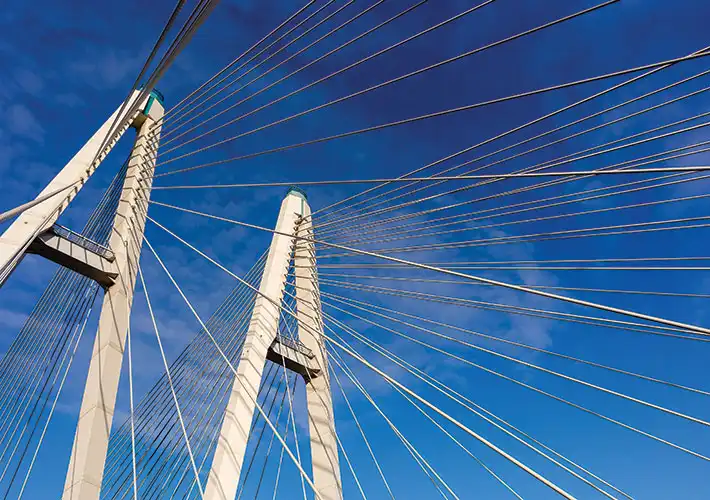
Welded Connections
Pins, rivets, and bolts are examples of mechanical fasteners forming non-rigid joints. A welded connection is not mechanical but rather is rigid one-piece construction. A properly welded joint, in which two pieces are fused together, is as strong as the joined materials. Similar to mechanical fasteners, welds are used to make structural connections between members and also to connect elements of a built-up member. Welds have also been used in the fabrication and erection of bridges as a way to temporarily hold pieces together prior to field riveting, bolting, or welding. Small temporary erection welds, known as tack welds, can cause serious fatigue problems to certain bridge members. Fatigue and fracture of steel bridge members are discussed in detail in Topic 8.1 (Welding is also used as a means of sealing joints and seams from moisture.

Pin and Hanger Connections
A pin and hanger connection is a type of hinge consisting of two pins and a hanger. Pin and hanger connections are used in an articulated (continuous bridge with hinges) or a suspended span configuration. The location of the connection varies depending on the type of bridge.

Splice Connections
A splice connection is the joining of two sections of the same member, either in the fabrication shop or in the field. This type of connection can be made using rivets, bolts, or welds. Bolted splices are common in multi-beam superstructures due to the limited allowable shipping lengths. Welded flange splices are common in large welded plate girders as a means of fabricating the most economical section.

Conclusion
Steel is an ideal material for bridges. It is an essential part of modern bridges because it is strong, can flex without fracturing and has a long life, even in the harshest conditions. It can be used to build bridges of any length because of its durability and ease of manufacture and maintenance. New grades of steel increase the economic advantages of steel, while ensuring that it meets the increasing demands for high performance.It dominates the bridge constructions for long span bridges, railway bridges, footbridges, and medium span highway bridges. It is now increasingly the choice for shorter span highway structures as well.
Sources – dit.sa.gov.au, road bridges.com, cedengineering.com, dot.state.mn.us, scincedirect.com, Aisc.org, Ispatguru, structurae.net, aisc.org gtgsteel.com, canambridges.com, wikimedia.org, erkrishneelram.files.wordpress.com, newcore.net.in, mercurynews.com, astm.org, delongsinc.com, sciencedirect.com, historicbridges.org.

